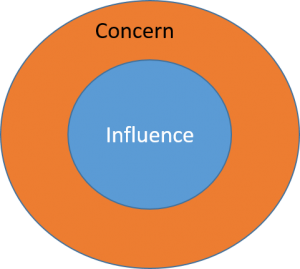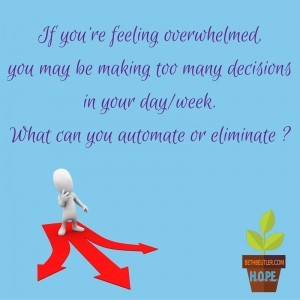Beth Beutler's Blog, page 24
September 12, 2016
One Key Quality, One Great Tool
Catch up on our first Facebook Live presentations
A few weeks ago, I started doing a Facebook live once a week, discussing a topic of interest to overwhelmed professionals, and have been pleased to see how many people are viewing these.
I’m also delighted to have discovered a way to embed these into my site. So for this week’s post, I’m including the first three Facebook live presentations so you can catch up. Hereafter, on the weeks I do one, I will post it on the site on Thursdays. Those who subscribe should get the video along with the weekly blog post on Mondays.
To join us live or directly on Facebook, friend or follow me here. I post an announcement the morning of the day I will do it. The presentation is 10 minutes or shorter (hence, Tips in 10) and often done at lunch time as a lunch and learn. But it’s always available to watch later as well!
Enjoy!
From 9/8/16: How to Have a Successful Re-entry After Vacation
From 8/31/16: One of my favorite desk tools
From 8/24/16: One of the Most Important Qualities of a Professional
For some reason, I cannot embed this one onto the post. But you can click here for it.
Question: What topics would you like to see in future Tips in 10? You can leave a comment by clicking here.

September 5, 2016
Guest Post: Unique Ways to Use a Paper Clip
One thing most professionals have is plenty of paper clips. I came across this video of several unique ways to use them besides the standard clipping of papers. Enjoy!

August 29, 2016
Do You Really Need to Do Your Best?
Making Sense of a Subjective Measure
“1st Olympics–4th Olympic medal (3 gold and 1 bronze) Y’all aight out there? bc Im more than happy!” – Simone Biles tweet
Leave it to a young person to remind us all what “doing your best” is all about. The girl who America hoped would come home with five medals–did–but not all gold. Yet, a golden attitude. She would probably say she “did her best” and I–for one–am proud of her.
“All I expect is for your to do your best.”
Did you ever hear that growing up? Do you hear it now from bosses and clients?
How do you know if you’ve really done your best on that project? How do you measure effort? By sales figures? Time spent? Money made? A grade received? Top awards in your industry?
One of the challenges I’ve faced in my small business is determining what “doing my best” means. In more concrete terms, since one of the primary goals of being in a business is to make a living, what level of financial success I should be shooting for?
In this season of life and for the foreseeable future, we have chosen for me to pursue my own business exclusively, without supplemental employment elsewhere (unless a clear opportunity presents itself.) In part, this is a lifestyle decision, not just a financial one. The fact is–pursuing other forms of employment could actually mean a better “bottom line” for us, but it would come at the cost of reduced flexibility, less time to pursue non-business goals, and a possible level of stress that doesn’t align with our current season as early empty-nesters.
But being an achiever type, it’s hard for me to just flow with my business and not have some type of goal. Are there ways achievers and goal setters can keep from driving themselves crazy or getting disheartened by less-than-hoped-for results? I think so. It means thinking less about “doing my best” and more about establishing reasonable goals as baseline minimums to meet the needs of the lifestyle we’ve chosen.
Now (especially clients) don’t panic–this doesn’t mean I intend to “slide” in my work. It does mean that instead of the conventional wisdom of having stretch goals, I am choosing to plan time to serve clients well and to reach a sensible income goal each month, while also hoping that over time, my steady investment into my business income streams will naturally bring additional increase.
Working toward a balanced perspective is really a form of doing your best. “Best” is subjective. It’s important to understand what “best” truly means to you, your clients, and your boss (even if your boss is yourself.) You may be surprised what you uncover by taking some time to think this through and discuss it with those close to you who may be affected (i.e. business partner or team, spouse, kids.)
For some, “best” might be a certain amount of revenue. For others, a certain amount of time each week spent on the job while also having time for other interests. Some customers may think your best is to be available to them 24/7, while others may respect that your best has boundaries. Be careful about how you define what “doing your best” means. Make sure it aligns with your values, capabilities, and personal/family needs. And above all, remember that doing your best is not just about money.

August 22, 2016
Why I’ve Cut Back on Working at Coffee Shops
Pros and Cons of Working Outside Your Office
Since I spend many hours by myself, I sometimes work at a coffee shop as a way to get out among the “land of the living.” Being in the presence of other people in a unique environment expands my perspective, supports my creativity, and gives me lingering time to think and create.
But it’s not always the most effective way to run my business.
I still make time for a coffee shop work session (sometimes referred to on my calendar as a “Writer’s Block”) almost every week. But recently, I have made it less of a priority as my hands-on commitments to clients have increased. I’ve had to ask myself if this practice was really a good fit for my current business responsibilities, and have discovered that it sometimes is not. Here are some reasons I’ve made the change. When I’m at a coffee shop, I find that:
I don’t accomplish as much billable time. HOPE serves VA clients via a pre-purchase bank system. Our typical client usually has a few random tasks per week, so I don’t always work a straight 2-3 hours at a time. By the time I add in travel time, purchasing and consuming my snack or food (unless it’s JUST a cup of coffee), I really don’t accomplish much billable time in a coffee shop session.
I can’t guarantee an effective environment. I’ll admit it. I’m kind of picky when it comes to what environment I want to have when working. I have my favorite spots at various coffee shops, and I feel out of sorts if one of those tables aren’t free. In my home office, I am in control of where I sit or stand to work!
It costs money. I believe that if you are going to camp out at someone’s business, you should at least make a small purchase. Thus, every time I go to a coffee shop, I am spending $3 to $10 depending on what time I go and what I get. This adds up. I have the same access to coffee and snacks at home.
It can be distracting. I must have earphones and music ready because it’s too easy for me to pick up on conversations around me. This is easily avoided at my home office.
I have less freedom. At home, I can sing or process out loud, walk around, or even scream at my computer. (Hypothetical of course.) At a coffee shop? Not so much unless I want weird looks.
I can effectively multi-task. Yeah, I know. Multi-tasking is taboo now. But there are some things that can be done in the background at home that can’t be done at a coffee shop. Laundry, for example.
I’m limited in the types of tasks I can do. My trusty Chromebook doesn’t owe me a dime. However, it just doesn’t replace the ease of my desktop set up for all kinds of tasks. There are certain ones I can pull off at a coffee shop, but not the quick administrative things that a VA often has to do such as set appointments, screen email, organize calendars, etc.
Now there ARE pluses to working at a coffee shop. A fresh perspective. The opportunity to have a casual conversation when crossing paths with someone. A change of pace. I’ll probably blog about that at another time because I still do visit coffee shops regularly. But for now, the thoughts above help me decide when and where it’s best to utilize them.
Over to you: Do you work at coffee shops regularly? Why or why not? You can leave a comment by clicking here.
Photo taken at Spill the Beans.

August 15, 2016
Make Easy Work of Alphabetizing
The Divide and Conquer Method

My client sent me a box of hundreds of 8.5 x 11 personalized sheets of paper in random order, along with imprinted labels. He needed these sheets sorted, labeled and mailed.
90% or more of my work for clients is done using technology. But on occasion, there are times to still do an “old fashioned” project like stuff a mailing. Despite claims for paperless offices that were predicted years ago, we still handle a lot of snail mail and paper files.
So, when you have a project like this and need to alphabetize it, what are the quickest ways to do it? Here is a method I’ve been using:
First: I divide sheets into two piles based on first letters of last name
A to K and L to Z.
The benefit of this is that it does not require a lot of thought to sort. I don’t want to get hung up in specific detailed alphabetizing yet.
Second: I divide the two piles into four, again using first letters of last names:
A-E / F-K / L-Q / R-Z
Notice that these divisions complement the first one of A-K and L-Z.
Third: Now taking one pile at a time, I further divide it by individual letter
A B C D Etc.
In this project, there were many recipients who were getting more than one sheet, but there was no need to match them exactly quite yet.
Fourth: Now working with each smaller pile, I sort and match everyone appropriately. If necessary, I move to further divisions using second letters of last name using vowels or common consonants, depending on what I feel will sort it fastest.
Now I can find the mailing label that matches the name.
The key to this divide and conquer method is to keep the number of piles to a minimum initially. The more spread out your project becomes, the more unwieldy it can get. Keeping divisions simple in the beginning, and then progressively more detailed, saves space and does not feel as overwhelming.
*The above scenario is partially fictional, to provide a helpful demonstration. However, it is based on a real-life project HOPE helped a client with. Contact us for your administrative support needs. Our pre-pay 5 or 10 hour package system allows for short term projects or long term relationships.

August 8, 2016
I Didn’t Tell Her I Got it for a Dollar
How and Why to Accept a Compliment
“I like your necklace. That’s unique.”
She was referring to a painted wood necklace I was wearing that had been trimmed with a piece of lace. It WAS unique. And a bargain.
I’d gotten that necklace for $1 at a small town shop that featured items from a variey of sellers–a sort of upscale flea market.
But I didn’t tell her that.
I was tempted to. After all, aren’t we inclined to downplay a compliment?
For the way you handled the client: “Oh that? It was no big deal.”
For the project you turned in early: “I’m usually not that good at this sort of thing.”
Regarding the new accessory in your business outfit: “I got this for only a dollar!”
For your overall contribution by being a “rock star:” “Well, I try.”
Why do we have such a hard time just accepting and enjoying recognition or appreciation? Maybe we feel like it’s arrogant to smile and say “thanks” rather than dismiss it. Or maybe we don’t have the confidence to believe the person giving the compliment may be right!
Overwhelmed professionals are often too busy flying through their day to pay much attention to compliments. They are always on a quest to do more, be more, accomplish more. They often feel like they don’t measure up. I know I struggle regularly with whether I’m contributing enough–whether my business is healthy enough. But compliments are a grace that can energize you and remind you of your valuable contributions to life and work. (Even if you are complimented on your haircut or outfit, it means you’ve done something to brighten the environment or to put your best foot forward!)
I challenge you to react differently the next time you are paid a compliment. Remember, a compliment is a gift from a person who didn’t have to bother to give it. Don’t discount their wisdom and opinion by refusing to accept it well. Instead, smile, say “Thank you, I really appreciate your kind words” and carry that gift of grace in your bank of happy memories.
Your turn: What’s a compliment you received that still warms your heart?

August 1, 2016
Are You Drinking Enough?
Hydration Motivation
The US is currently experiencing a heat wave, so I welcome this timely information as a special guest post from Quill (with an infographic designed by Ghergich & Co. )
When you think of all the necessities for your employees to do their jobs well, you probably think about the basics like desks and computers. But what about a more basic need—water?
Of course, everyone knows that we all need water; it’s what the body is mostly made up of. But what many don’t realize is that even sitting at an office job, you’re likely to lose water—it just happens. When you lose water and don’t replace it, you’re inhibiting your brain function, which also inhibits cognitive skills like clarity and focus. All of that can happen to every employee at work, which means their output is likely to suffer, too.
There are things you can do at your workplace to help your employees hydrate more each and every day. Use this graphic to figure out how you can make your workplace a better, more hydrated environment.

Infographic by Quill

July 25, 2016
How an Off Kilter Day Still Turned Out OK
It may start bad, but doesn't have to end bad.
It was a Monday. The day of the week I typically plan to be a high productivity day to power through client and personal responsibilities. But this one wasn’t starting out that way.
I got distracted by a quirk in my smart phone that I couldn’t get rid of. Because, you know, I just can’t let that irritating notification stay there. An hour or so of playing around and researching–with no solution–pushed the schedule out of whack.
Add to that a couple of important but extended conversations, a television broadcast of a favorite sporting event that had been rain delayed from Sunday, and the typical myriad of daily tasks, and I was positioned for a less-than-successful Monday.
Yet, it turned out pretty satisfying.
As I reflect on why, the following reasons come to mind:
I still made time for fundamentals. Despite starting my day later, I went ahead and did my whole morning routine, which included exercise and meditation/reading/writing time. I could have cut that short, but it was worth it to go ahead and do it.
I knocked out my least favorite household chore–vacuuming. I’d gotten slack about vacuuming, and experimented with doing it at the first of the week. Not only did it make the house neater, it felt good mentally to have it off the plate.
I invested in people. The two conversations gave me opportunity to give people I love some time. Using earphones for one, I was able to also do a mindless chore while keeping up the conversation, which was a win-win. Even better, some words of affirmation came to me that I could share, which really encouraged this person.
I chose to embrace moments of relaxation. I went ahead and watched the ending of the sporting event (I’d had it running in the background earlier.) I watched an episode of a series early in the evening.
I’d prepared some food ahead. I’d already roasted cabbage and spaghetti squash on the weekend, so my meal prepping didn’t take long. I simply seasoned pork chops and put them in to bake. So the kitchen routine for the night was not long nor stressful–preparing ahead of time rescued me.
The one area of disappointment was that I did not reach my “billable hours” goal for the day for my business. However, my clients were still taken care of, which is the more important thing.
I realize now that the key to the day was way back in the beginning of it when it went off track. Since I had the flexibility to do so, going ahead and working through my normal fundamental routine re-calibrated me and prepared me for the day. Loosening my grip a bit on the work goals helped too.
And I’m choosing to live with the smartphone quirk. I still see that notification when I use power save mode. And maybe, it can serve as a good reminder to go through even Mondays in a more balanced way.
So how about you? What one routine can you use to re-group when you feel your day go off-kilter? You can leave a comment by clicking here.

July 18, 2016
When External “Stuff” Overwhelms
Ideas for coping when your world is unsettled
If your workload isn’t enough to overwhelm you, there is often outside “stuff” that zaps your energy, and even your soul.
As I write this, our community and nation are facing crisis. I won’t be using this forum to discuss my viewpoints…I like the blog to remain evergreen and somewhat sadly, I have a feeling that whenever this post is read now and in the future, there will be some type of external situation that can distract and interrupt your productivity at work. These include:
Community, national, or worldwide events that are tragic, confusing, or deeply sad
Personal issues in your relationships with those close to you
Health issues you may be dealing with
Financial trouble
Acts of nature such as earthquakes, floods, and fires.
Whether we want to admit it or not, these external forces can wrap around our brains and hearts and make it very hard to focus on the work in front of us. Here are a few ideas to help.
Realize that maybe, it’s okay to be distracted for a bit. Events and personal situations require adequate time to process. Business owners should be aware that their team members may need some time to personally adjust to major events or personal issues. Sensitivity to leaves of absence, a temporarily reduced schedule, or assistance programs such as counseling can show your concern for your team. If you are a solo-preneur like me, allowing yourself time to refresh and recalibrate can ultimately help your productivity.
Do good work. I have people in my life that have jobs that that regularly put them in direct contact with people going through difficult times. My best encouragement to them is to “Do good work”–to do what they are trained and called to do. They may only interact with a small circle of people, but good work has a ripple effect. The same applies to those of us not directly involved with front line care positions such as those of first responders, medical personnel or counselors. The work WE are called to is still an important element of life and community. Do good work and it will have a positive affect.
Understand the difference between the circle of concern and the circle of influence. This concept does not originate with me (see this link for a reference to Stephen Covey) But it’s a helpful idea. In our lives, there are areas that we have a direct influence on…for example, our immediate family, workplace or neighborhood. (This could extend a little farther depending on our platforms.) But outside of that is a circle of concern–things that may get our attention and cause us to ponder, but for practical purposes and our own sanity, we cannot get directly involved in other than perhaps giving to a cause or offering a word of encouragement or do some tangible act of service. Examples may be things that happen in other families, many states away, etc. This difference is NOT to say you never show love outside your own circle, but that you remain intentional about your emotional limitations and use your best gifts for the circle of influence you most logically have–not neglecting your own family, clients, etc while serving others beyond your immediate circles.
Take time for self-care. I like to remember that you “cannot pour from an empty pitcher.” Find ways to recalibrate yourself–preferably away from screens and social media. Interacting with pets or getting out into nature, or spending time with close friends or family are all ways you can regain perspective. One of my clients specializes in this and provides regular encouragement and ideas for self-care.
Limit your exposure. I know cake exists, but I don’t have to eat it everyday. I struggle with this when it comes to information (not cake so much.) The internet allows us to quickly search anything, dive into social media feeds, or scan headlines. But too much information can weary and disturb our equilibrium. I’m not suggesting never to get a summary of headlines or listen to commentators, but a steady diet of talk radio, social media, and news can create an imbalance in our spirit and even bring on a feeling of hopelessness and ingratitude. Set whatever boundaries you need to that cooperate with your tolerance for negativity (which most of that stuff is.) Recently, I’ve found a weekday summary called The Skimm to be a helpful but not overwhelming summary of world and US news. It’s written with a conversational tone and has a balance of quick topics to keep negativity at bay. I’ve also subscribed to a local version in our region called Greenville Today.
While we can’t always change outside circumstances, we can change our approach to them and what we allow to invade our peace. You are the gatekeeper for what you allow in your head and heart. Take responsibility and spend the energy doing good work instead.

July 11, 2016
Reduce the Number of Daily Decisions You Have to Make
What can you automate or eliminate?
I’m back to bowling. I’ve joined a weekly league, and also receive two free practice games a week. I enjoy this activity for several reasons, and I’m encouraged when I see myself improved.
But,
I don’t enjoy being coached.
I’m the kind of person that wants something to feel natural pretty quickly, and like to learn on my own. When interacting with a coach, I start to feel easily overwhelmed. Coaching types mean well, but if they aren’t careful, they can give you too many suggestions at once. Stand this way. Hold your arm/wrist/hand/big toe like this. Look at the spot. The arrow. The pins. Start closer. Lift your ball this way. Don’t swing like a gate. (I exaggerate, but you get the idea.)
All these ideas start feeling like that many more decisions to make and things to remember. Sometimes, it’s best to just go up and throw (roll) the ball.
The same thing applies to our daily life and work.
According to this article, we make around 35,000 decisions per day. 35,000! Each of those decisions requires use of our brains…no wonder we’re tired!
Is there a way to take control of this? Yes, at least to some degree.
Reduce the need for decision making by limiting choices and automating certain routines. Here are some ideas that are working for me:
Clothing: Since I work from home a lot, I don’t need a major wardrobe. Plain colors in primarily sporty styles that I can accessorize with scarves or jewelry work best for this season of my life.
Menu planning: I use Google calendar to plan out meals, making many meal ideas recur monthly or every-so-many weeks. I’m at the point now where every day of the month has a meal suggestion. Then when I look at my weekly calendar, I can move individual meals around to suit that week’s appointments, or stick in a new idea if I feel like it.
Morning and evening routines: I have certain things I do on all weekday mornings unless I have to leave early for an onsite assignment or meeting. I have certain things I do in the evenings to set me up for a better tomorrow.
Associations: I’m experimenting with doing certain types of work to particular playlists or locations (i.e. coffee shops or home office) My hope is that my brain will automatically kick into the gear needed for that type of work when listening to that music or when in that environment.
Your turn: What one decision can you automate to ease your mind?
You can leave a comment by clicking here.























